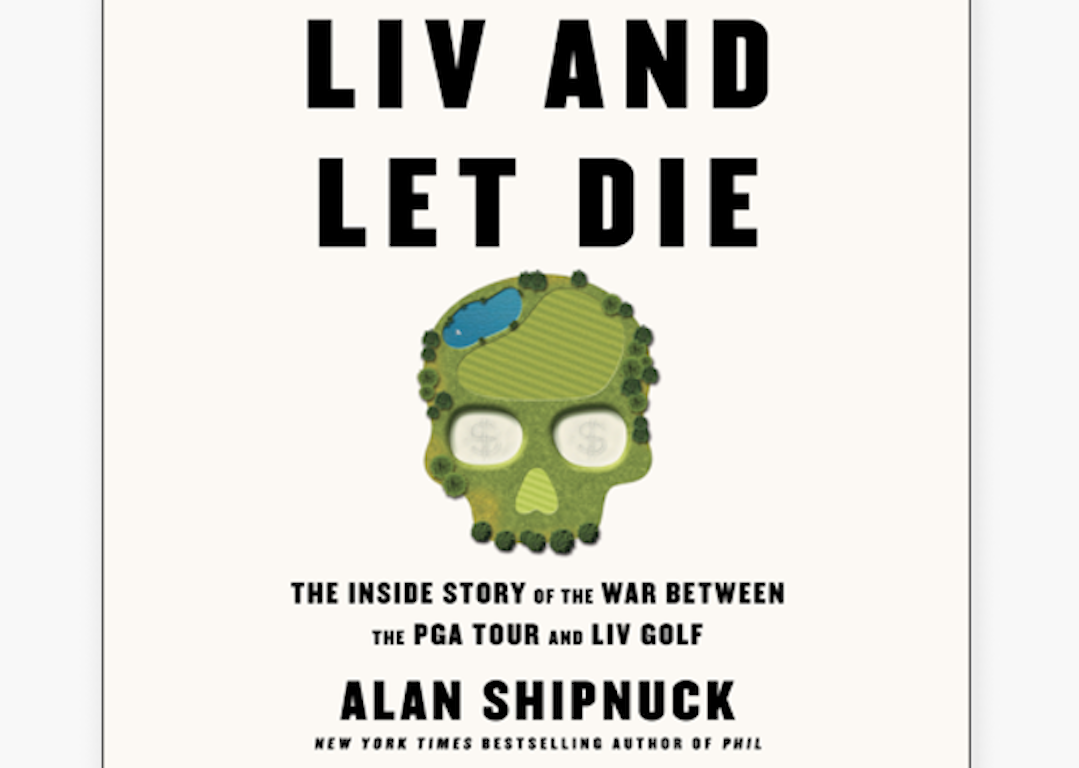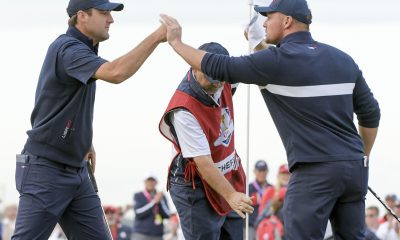Opinion & Analysis
For whose eyes only? A review of Alan Shipnuck’s LIV and Let Die

I’m not encouraging you to skip the first 323 pages of Alan Shipnuck’s coverage of the rise and continued rise of the LIV golf experiment. The ship has sailed from port and the facts are etched in the Earth’s rotations. I’m suggesting that you begin at the end, with the paragraph at the bottom of page 324. It begins Amid all the speculating and pontificating… and ends with three words: changed golf forever. My reasoning is mildly complicated: I want you to understand what you’re taking on, for however long it takes to finish the tome. This story is worthwhile, but it is not a dalliance. It will take you back two, three, four years, to emotions that you had forgotten to lock away.
There were many prescient followers of the professional game, who considered LIV to be the second coming of Covid-19, albeit with a victim pool interested only in golf. There was a multitude of the lesser-informed, who latched onto words like betrayal, isolation, and sportswashing, in an effort to understand what was happening in the game of professional golf. Social media apps were awash in uncountable numbers of questions, opinions, accusations, and outright truths and lies, about what was going on with a league that snatched some of the best male touring professionals away from the PGA Tour.
It seemed that, with each passing moment, the massive We was more confused and more uncertain of the road map. Fortunately, we in golf have Alan Shipnuck in our midst. As with all the great writers on the four-lettered game that preceded him, Shipnuck mercilessly pursues a story that doesn’t matter for a moment. He pursues a story that defines an era, reveals character, and translates language not accessible to the masses. If Esperanto was the hope of the late 1800s, consider the language of the world’s wealthiest insiders to be Otnarepse. Very few spoke (or had interest in speaking) Esperanto, and even fewer have access to Otnarepsa. Shipnuck does.
LIV and Let Die is the factual recounting of how the kingdom of Saudi Arabia took an interest in golf, spurred on by an unforgiving, onetime lover of the PGA Tour. It is the story of how an English lawyer’s idea for collaborative golf at the highest level, was at best, emulated; at worst, stolen in the night, and massaged into something impactful. The tale collects a character roll-call that excludes hardly any names that you know, including some long dead.
I picked up my advance copy of LIV and Let Die on a Wednesday, and finished it by Sunday morning. It would have been sooner, so transfixed was I by reveal after reveal, but a prearranged drive through 9.5 hours of the USA, followed by a homecoming, delayed its completion. Along the path of pages, I recalled what it is that most agitates me about Shipnuck’s writing: he seems to take sides, then doesn’t, then switches, then switches back. His research and writing are measured and do their level best to present as many elements of the story, as can fit inside the cover.
There are moments when I wonder how Shipnuck is able to gain the access that he does, to the important persons that continue to shape this story. For some, their massive egos demand coverage and inclusion. For others, they admit that if their story must be told, it should be told by a writer who continues to produce volumes highlighted by thorough, accurate research.
Alan Shipnuck is direct and pointed in his commentary. He does not shy away from controversy, and at times, I wonder how he avoids bodily harm. His words can bruise, cut, and snap, but they are never fraudulent nor off the mark. His work is a welcome addition to the two centuries of golf writing that we may access.
LIV and Let Die traces the arc that began with the return of Greg Norman to the world golf stage, through the defection of the initial 48 golfers, away from the behemoth PGA Tour, to the ultimate announcement that the Saudi PIF would work with the US PGA Tour and the European PGA Tour (the DP World Tour) to continue the “evolution” of professional men’s golf.
Live and Let Die is unique reading -the rear of the dust jacket presents “A small sample of the bitching, bombast, and backstabbing found within,” instead of the amalgamation of quotes from fawning admirers and supporters. Shipnuck utilizes public and anonymous sources fluidly, in order to straighten as many of the story’s tentacles as possible. I suspect that you will find yourself backing up and rereading segments, and I encourage you to keep a highlighter handy for the taking of notes. This isn’t a college course, but hours spent reading are worth our time, to validate the author’s effort.
Opinion & Analysis
The 2 primary challenges golf equipment companies face

As the editor-in-chief of this website and an observer of the GolfWRX forums and other online golf equipment discourse for over a decade, I’m pretty well attuned to the grunts and grumbles of a significant portion of the golf equipment purchasing spectrum. And before you accuse me of lording above all in some digital ivory tower, I’d like to offer that I worked at golf courses (public and private) for years prior to picking up my pen, so I’m well-versed in the non-degenerate golf equipment consumers out there. I touched (green)grass (retail)!
Complaints about the ills of and related to the OEMs usually follow some version of: Product cycles are too short for real innovation, tour equipment isn’t the same as retail (which is largely not true, by the way), too much is invested in marketing and not enough in R&D, top staffer X hasn’t even put the new driver in play, so it’s obviously not superior to the previous generation, prices are too high, and on and on.
Without digging into the merits of any of these claims, which I believe are mostly red herrings, I’d like to bring into view of our rangefinder what I believe to be the two primary difficulties golf equipment companies face.
One: As Terry Koehler, back when he was the CEO of Ben Hogan, told me at the time of the Ft Worth irons launch, if you can’t regularly hit the golf ball in a coin-sized area in the middle of the face, there’s not a ton that iron technology can do for you. Now, this is less true now with respect to irons than when he said it, and is less and less true by degrees as the clubs get larger (utilities, fairways, hybrids, drivers), but there remains a great deal of golf equipment truth in that statement. Think about it — which is to say, in TL;DR fashion, get lessons from a qualified instructor who will teach you about the fundamentals of repeatable impact and how the golf swing works, not just offer band-aid fixes. If you can’t repeatably deliver the golf club to the golf ball in something resembling the manner it was designed for, how can you expect to be getting the most out of the club — put another way, the maximum value from your investment?
Similarly, game improvement equipment can only improve your game if you game it. In other words, get fit for the clubs you ought to be playing rather than filling the bag with the ones you wish you could hit or used to be able to hit. Of course, don’t do this if you don’t care about performance and just want to hit a forged blade while playing off an 18 handicap. That’s absolutely fine. There were plenty of members in clubs back in the day playing Hogan Apex or Mizuno MP-32 irons who had no business doing so from a ballstriking standpoint, but they enjoyed their look, feel, and complementary qualities to their Gatsby hats and cashmere sweaters. Do what brings you a measure of joy in this maddening game.
Now, the second issue. This is not a plea for non-conforming equipment; rather, it is a statement of fact. USGA/R&A limits on every facet of golf equipment are detrimental to golf equipment manufacturers. Sure, you know this, but do you think about it as it applies to almost every element of equipment? A 500cc driver would be inherently more forgiving than a 460cc, as one with a COR measurement in excess of 0.83. 50-inch shafts. Box grooves. And on and on.
Would fewer regulations be objectively bad for the game? Would this erode its soul? Fortunately, that’s beside the point of this exercise, which is merely to point out the facts. The fact, in this case, is that equipment restrictions and regulations are the slaughterbench of an abundance of innovation in the golf equipment space. Is this for the best? Well, now I’ve asked the question twice and might as well give a partial response, I guess my answer to that would be, “It depends on what type of golf you’re playing and who you’re playing it with.”
For my part, I don’t mind embarrassing myself with vintage blades and persimmons chasing after the quasi-spiritual elevation of a well-struck shot, but that’s just me. Plenty of folks don’t give a damn if their grooves are conforming. Plenty of folks think the folks in Liberty Corner ought to add a prison to the museum for such offences. And those are just a few of the considerations for the amateur game — which doesn’t get inside the gallery ropes of the pro game…
Different strokes in the game of golf, in my humble opinion.
Anyway, I believe equipment company engineers are genuinely trying to build better equipment year over year. The marketing departments are trying to find ways to make this equipment appeal to the broadest segment of the golf market possible. All of this against (1) the backdrop of — at least for now — firm product cycles. And golfers who, with their ~15 average handicap (men), for the most part, are not striping the golf ball like Tiger in his prime and seem to have less and less time year over year to practice and improve. (2) Regulations that massively restrict what they’re able to do…
That’s the landscape as I see it and the real headwinds for golf equipment companies. No doubt, there’s more I haven’t considered, but I think the previous is a better — and better faith — point of departure when formulating any serious commentary on the golf equipment world than some of the more cynical and conspiratorial takes I hear.
Agree? Disagree? Think I’m worthy of an Adam Hadwin-esque security guard tackle? Let me know in the comments.
@golfoncbs The infamous Adam Hadwin tackle ? #golf #fyp #canada #pgatour #adamhadwin ? Ghibli-style nostalgic waltz – MaSssuguMusic
Podcasts
Fore Love of Golf: Introducing a new club concept

Episode #16 brings us Cliff McKinney. Cliff is the founder of Old Charlie Golf Club, a new club, and concept, to be built in the Florida panhandle. The model is quite interesting and aims to make great, private golf more affordable. We hope you enjoy the show!
Opinion & Analysis
On Scottie Scheffler wondering ‘What’s the point of winning?’

Last week, I came across a reel from BBC Sport on Instagram featuring Scottie Scheffler speaking to the media ahead of The Open at Royal Portrush. In it, he shared that he often wonders what the point is of wanting to win tournaments so badly — especially when he knows, deep down, that it doesn’t lead to a truly fulfilling life.
View this post on Instagram
“Is it great to be able to win tournaments and to accomplish the things I have in the game of golf? Yeah, it brings tears to my eyes just to think about it because I’ve literally worked my entire life to be good at this sport,” Scheffler said. “To have that kind of sense of accomplishment, I think, is a pretty cool feeling. To get to live out your dreams is very special, but at the end of the day, I’m not out here to inspire the next generation of golfers. I’m not out here to inspire someone to be the best player in the world, because what’s the point?”
Ironically — or perhaps perfectly — he went on to win the claret jug.
That question — what’s the point of winning? — cuts straight to the heart of the human journey.
As someone who’s spent over two decades in the trenches of professional golf, and in deep study of the mental, emotional, and spiritual dimensions of the game, I see Scottie’s inner conflict as a sign of soul evolution in motion.
I came to golf late. I wasn’t a junior standout or college All-American. At 27, I left a steady corporate job to see if I could be on the PGA Tour starting as a 14-handicap, average-length hitter. Over the years, my journey has been defined less by trophies and more by the relentless effort to navigate the deeply inequitable and gated system of professional golf — an effort that ultimately turned inward and helped me evolve as both a golfer and a person.
One perspective that helped me make sense of this inner dissonance around competition and our culture’s tendency to overvalue winning is the idea of soul evolution.
The University of Virginia’s Division of Perceptual Studies has done extensive research on reincarnation, and Netflix’s Surviving Death (Episode 6) explores the topic, too. Whether you take it literally or metaphorically, the idea that we’re on a long arc of growth — from beginner to sage elder — offers a profound perspective.
If you accept the premise literally, then terms like “young soul” and “old soul” start to hold meaning. However, even if we set the word “soul” aside, it’s easy to see that different levels of life experience produce different worldviews.
Newer souls — or people in earlier stages of their development — may be curious and kind but still lack discernment or depth. There is a naivety, and they don’t yet question as deeply, tending to see things in black and white, partly because certainty feels safer than confronting the unknown.
As we gain more experience, we begin to experiment. We test limits. We chase extreme external goals — sometimes at the expense of health, relationships, or inner peace — still operating from hunger, ambition, and the fragility of the ego.
It’s a necessary stage, but often a turbulent and unfulfilling one.
David Duval fell off the map after reaching World No. 1. Bubba Watson had his own “Is this it?” moment with his caddie, Ted Scott, after winning the Masters.
In Aaron Rodgers: Enigma, reflecting on his 2011 Super Bowl win, Rodgers said:
“Now I’ve accomplished the only thing that I really, really wanted to do in my life. Now what? I was like, ‘Did I aim at the wrong thing? Did I spend too much time thinking about stuff that ultimately doesn’t give you true happiness?’”
Jim Carrey once said, “I think everybody should get rich and famous and do everything they ever dreamed of so they can see that it’s not the answer.”
Eventually, though, something shifts.
We begin to see in shades of gray. Winning, dominating, accumulating—these pursuits lose their shine. The rewards feel more fleeting. Living in a constant state of fight-or-flight makes us feel alive, yes, but not happy and joyful.
Compassion begins to replace ambition. Love, presence, and gratitude become more fulfilling than status, profits, or trophies. We crave balance over burnout. Collaboration over competition. Meaning over metrics.
Interestingly, if we zoom out, we can apply this same model to nations and cultures. Countries, like people, have a collective “soul stage” made up of the individuals within them.
Take the United States, for example. I’d place it as a mid-level soul: highly competitive and deeply driven, but still learning emotional maturity. Still uncomfortable with nuance. Still believing that more is always better. Despite its global wins, the U.S. currently ranks just 23rd in happiness (as of 2025). You might liken it to a gifted teenager—bold, eager, and ambitious, but angsty and still figuring out how to live well and in balance. As much as a parent wants to protect their child, sometimes the child has to make their own mistakes to truly grow.
So when Scottie Scheffler wonders what the point of winning is, I don’t see someone losing strength.
I see someone evolving.
He’s beginning to look beyond the leaderboard. Beyond metrics of success that carry a lower vibration. And yet, in a poetic twist, Scheffler did go on to win The Open. But that only reinforces the point: even at the pinnacle, the question remains. And if more of us in the golf and sports world — and in U.S. culture at large — started asking similar questions, we might discover that the more meaningful trophy isn’t about accumulating or beating others at all costs.
It’s about awakening and evolving to something more than winning could ever promise.
















geohogan
Nov 20, 2023 at 2:29 pm
Norman, Michelson and DT are among the most polarizing figures in the past decades. Shipnuck’s research and writing is needed, because the fore mentioned
trio can be relied upon for fake news.
Andrew Taylor
Nov 6, 2023 at 3:07 pm
Alan Shipnuck is just trying to keep himself relavent and he along with other media, especially Brandel Chamblee, do a great job of stirring the pot. I would not read his trash just as I no longer watch The Golf Channel.
Jolter
Nov 6, 2023 at 11:37 am
From what I have read it appears the author takes a strong dislike for a former president and his family along with Norman, and Mickelson. It is almost like he has taken as strong a stance as certain Golf Channel analyst.